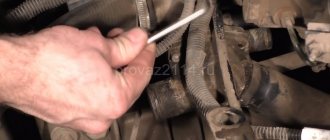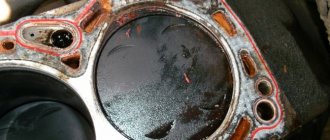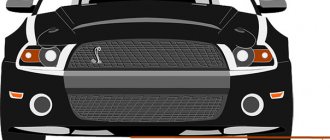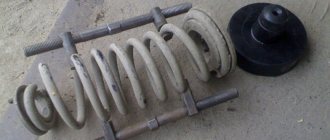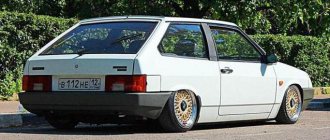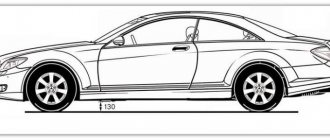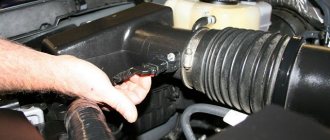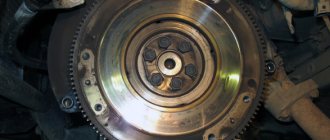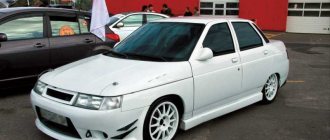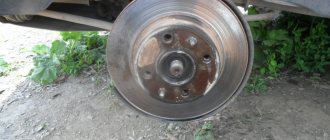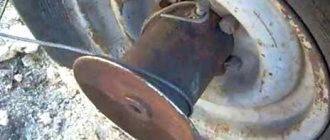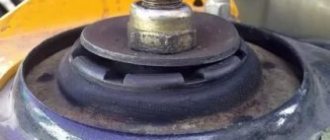It often happens to car owners when, when choosing a rim, its offset does not meet the necessary requirements. To change this characteristic, you can install disc spacers. This method can be used if the offset remains within the permissible values set by the manufacturer. Inexperienced car owners believe that metal inserts between the hub and the disk are used as a kind of tuning to change the appearance. But the suspension performance parameters and driver safety largely depend on the reach.
How to choose spacers
Knowledgeable auto mechanics recommend installing spacers when the offset is increased and exceeds the factory parameters. The main parameter when choosing is the quality of parts. If the location of the holes and dimensions are not suitable, or during installation a noticeable wobble of the suspension is detected, such operation of the vehicle is prohibited. Otherwise, the car's chassis will deform and wear out quickly.
Attention! It is prohibited to use spacers on the hub made by unknown manufacturers or using a homemade method.
Advice from experienced drivers on choosing these parts:
- Do not try to choose the thickest parts - increasing the reach often leads to a decrease in the safety of the driver and passengers while driving.
- For the rear and front axles of the car, select different thicknesses of the parts, since the track width in front and behind is different.
- When purchasing, carefully inspect the parts: they should not have visible defects, heterogeneity of material, or unpolished surfaces.
You cannot install several spacers on one wheel at once, as this will increase the load on the hub bearing. As a result, after a few months it will have to be replaced with a new one. In addition, levers, rods and other suspension elements are also subject to excessive stress.
Myths about spacers
Before choosing these elements, you should familiarize yourself with existing myths:
- Russian-made inserts are always of high quality and inexpensive. This is not always the case; only a few manufacturers in Russia produce products of adequate quality. Therefore, their cost exceeds foreign samples.
- Spacers and adapter bushings from China are cheaper, but the quality remains at a high level. This is also a misconception, since low prices are obtained due to savings by Chinese manufacturers on the quality of the material. Therefore, products from China often have a short service life. Threaded rods often break, spacers have pores and cavities in the metal. The accuracy of the equipment in the Celestial Empire is low, so the manufactured parts have increased runout. The protective coating in Chinese factories is not reliable enough, and the surface of parts quickly rusts.
- All world brands of car accessories are manufactured in China. If you check certificates and product passports from official dealers, you can find different countries of production.
How to measure the offset with your own hands
You can always measure this parameter yourself if you have the tools:
- Roulette or ruler.
- A wooden strip no less than the diameter of the disk.
- Jack. You will need it to remove the wheel.
- Key for removing the cylinder, lock (if there are bolts with non-standard heads).
First you need to measure the offset “A”. To do this, place the wheel with the back side facing up. Place the rail on the inside so that its ends are on the edges of the rim, but do not touch the tire. Now measure the distance from the edge of the rail to the mating surface.
Next, measure the offset “B”: the wheel should be face up and the rack should be on the rim. Determine the distance from the edge of the rack to the mating plane of the disk.
After taking measurements, you can make a simple calculation of the offset using the formula:
ET = (A + B) / 2-B, where A and B are the rear and front margins, respectively. Using this formula, the ET offset is calculated in millimeters.
What happens if the tracks are different
The track of the front wheels may not coincide with the track of the rear wheels, and if changes to one of them are made without the second, then the engine power consumption will be more significant when laying the track with the rear wheels. Thus, the force of the resisting movement will increase, and the permeability will, accordingly, decrease.
The front and rear tracks are usually not identical for vehicles with single and dual wheels.
Through trial and error, it was found that the difference between the tracks of single wheels should not be more than thirty percent of the tire width.
In general, the track affects not only the cross-country ability of the vehicle, but also the operating features. The track width, for example, is an important factor when planning the width of inspection pits in car repair shops.
How to install spacers
There are several recommendations and schemes for installing wheel spacers. Here is the basic generally accepted procedure.
- Carefully remove dirt and corrosion from the hub surface using a wire brush.
- Place the part on the disk and check that it fits tightly with the centering protrusion and chamfer to the surface.
- Check that it fits tightly to the surface of the hub with the internal chamfer and centering belt.
- Remove the mounting bolts, clamps, and centering pins (if any).
- Inspect the installation bolts, comparing them with the factory ones. In this case, the thread length should be greater by the size of the spacer thickness. The seat cone must exactly match the mating surface. If the stock wheel bolts have a movable spherical or conical surface, then the extended bolts should have one too.
- Secure the spacer to the hub with long bolts, aligning the mounting holes in advance.
- After installation, check that the mounting bolts do not touch the internal elements of the hub or caliper.
- The tightening torque of the mounting bolts is 100 N*m.
Installation must be done carefully so as not to damage the parts or strip the threads of the vehicle fasteners. First, you need to tighten two opposite bolts on the wheel, and then the rest.
Attention! Tighten the bolts with a torque wrench; an impact driver will not accurately create the required tightening force.
After installation, rotate the wheels in a suspended state and check whether the wheels are touching the body parts. After driving 100 km, it is recommended to check the tightness of the bolts and tighten them if necessary. Self-processing of parts is prohibited.
Wheel spacers are a tool for tuning and installing non-standard wheels, widening the track and giving the car a sporty look. But an important point is the careful selection of these elements, taking into account our recommendations.
conclusions
When weighing all the pros and cons of installing such a part, you need to remember the following: the spacer is an important connecting element that absorbs loads when moving and is responsible, among other things, for the safety of movement on the machine. It makes changes to the chassis of the car, changes the suspension geometry, thereby influencing the operation of individual components and assemblies. Therefore, when installing spacers, it is necessary to take compensating measures and carry out additional adjustments to the chassis in order to preserve the factory characteristics of the car as much as possible.
In order to minimize the negative impact of this part, it is worth buying spacers designed for a specific car model. Prices can be found here
Conditions of use
If we consider this issue from a mechanical point of view, then the only conclusion suggests itself is that the use of wheel spacers is permissible only in cases where the offset is greater than the standard one. In this case, the width of the part itself (in millimeters) must exactly match the difference between the actual and required overhang.
It should also be understood that the key aspect when choosing a spacer for a disk is the quality of its manufacture. If the alloy of the part is not homogeneous, or there are errors (even minor ones) in the location of the bolt holes, then wheel damage is very likely, which will literally destroy the car’s suspension in the shortest possible time. And in extreme conditions, these unaccounted for critical loads can even lead to instant destruction of the suspension, with all the ensuing consequences.
All of the above should warn every car enthusiast from purchasing the handicraft parts in question, and also avoid purchasing products from an unknown manufacturer.
Advantages of centering rings
Firstly, the correct position of the wheel parts ensures safe driving. Besides:
- Fastening elements are not subjected to unnecessary loads. Their unauthorized unscrewing is excluded.
- Suspension vibration disappears, rubber wears evenly.
- The steering wheel does not experience any beating, which appears only after installing a “non-original” disc. The runout becomes very noticeable at high speeds.
- Wheels do not require frequent balancing.
Thanks to the centering rings, fewer accidents occur.
Consequences of different widths
Of course, cars can have different track widths, and when driving on high-quality and hard roads there is not much difference. However, if you encounter loose soil on your way, then the unequal distance of the front and rear tracks can play a cruel joke on you. A car on such a road can easily get stuck. In any case, the cost of the car's engine will be incredible, because instead of two lanes it will have to lay all four. The car, of course, loses speed, which, you see, is not very convenient.
Track extenders have different indicators: mounting method, size, thickness.
If your vehicle's track width is different from the road track you are driving on, driving will be difficult. Historically, this fact is confirmed by jeeps used during the Second World War. Their track width was narrower than that of trucks. Because of this, jeep drivers following in their tracks were forced to move along one left track and run the second along the ridge between the wheels. In domestic jeeps this drawback has been eliminated.
Varieties
Spacers to prevent an increase in overhang can be:
- With drilled through holes for hub mounts. In this case, you may need to replace the standard bolts with longer ones (so that the length increases exactly by the width of the component). The thickness of such models is no more than 10 mm.
- With drilled holes for bolts and separate threaded holes for fasteners. This allows you to attach the component independently to the hub by screwing the wheel rim to it. This allows you not only to reduce the indicator, but also to change the number of bolts and, accordingly, the distance between them. Products of this type are usually equipped with a bulge that centers the wheel.
Wheel spacers with drilled through holes for hub mounts
Products can be of the following thickness:
- up to 10 mm. Due to their small thickness, they are used if there is a need to install a disc with characteristics unsuitable for the car, preventing it from coming into contact with the car’s caliper. Recommended for sports car tires;
- 12-25 mm. They are equipped with a hub that significantly increases the wheelbase, so they are often an element of car decor. In addition, such elements prevent wheel sinking, which can often be observed when installing arch extensions or body kits;
- 25-50 mm. They can be equipped with bolts connecting the structure to the hub, or studs. The second type is suitable for cars with wheel nuts (no need to buy additional long studs), as well as jeeps.
Duralumin wheel spacer with 4x98 drill bit, 30 mm thick
Wheel components are divided into the following types according to their intended purpose:
- Departure correcting. Among the negative consequences of their installation, it is worth noting a slight increase in wheel imbalance.
- Correcting hole diameter in the center of the wheels. They are used if the diameter of the disk hole exceeds the standard value.
- Mixed. Such models are rare and combine two functions.
Spacers to increase the road track
